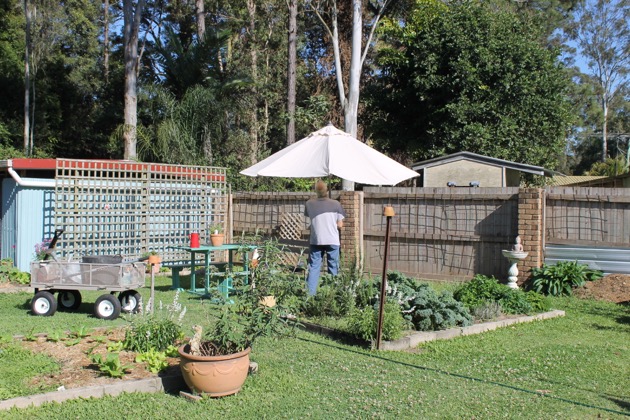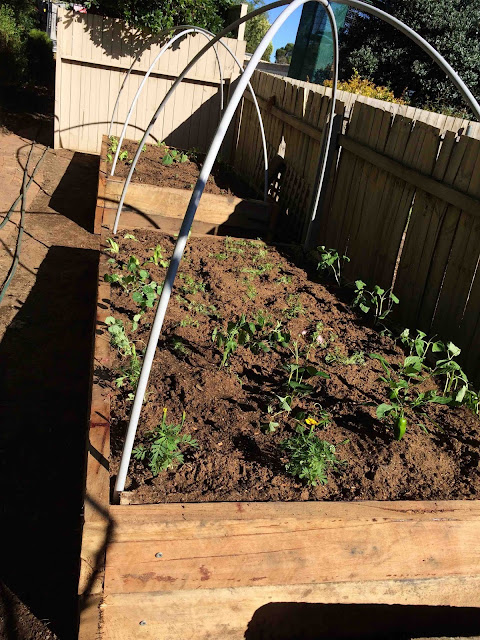Well, after all this time, I finally feel that the garden is ready to be photographed. We usually start our annual planting in March to take advantage of the cooler weather but this year, we're only gardening in spring and summer and that means Spring planting. Our crops now will be mostly salad related, herbs and fruit. Cutting down on how much we grow allows us to continue growing food in the backyard while reducing the workload that was getting too much for us.
In addition to the in-ground crops, we've also done some work on the back verandah which faces north-west. A few months ago we had shade blinds fitted and in doing so, we're now able to grow plants in containers and have a table and chairs to sit at. In high summer, when it's hot and humid, we'll either be on the front verandah, which is on the cooler side of the house, or inside with the fan or air conditioner on. But the way it's set up now allows us to use the back verandah much more.
Before that hot weather arrives there is still a lot to be done outside so we have a constant supply of organic salad leaves and vegetables over summer. Right now we're growing all the herbs we use: parsley, Welsh onions, thyme, basil, sage, oregano, comfrey and rosemary. Our winter crops of curly kale and turnips have continued into spring and will continue to grow well right into summer. We also have ginger, several varieties of chilli, capsicum (pepper), rosellas for tea and jam, lettuce, silverbeet (Swiss chard), beetroot, cherry tomatoes (Rapunzel) and large tomatoes (short beefsteak), red radishes, Lebanese cucumbers, bok choy and Daikon radishes. Our fruits include: raspberries, blueberries, Young berries, elderberries, passionfruit, lemons, oranges, mandarins, loquat and bananas. As you can see in the photos, we've planted flowers dotted here and there to attract the pollinating insects. And I've planted up a tray of thickly sown mixed salad leaves in the bush house. They'll keep growing when the lettuces in the garden bolt to seed in the hotter weather. These mixed leaves are a cut-and-come-again crop and I hope they'll see us through summer.

One of the gardening team sets up the work station for the day. Yesterday was our first hot day and we needed that umbrella.
Washing on the line, umbrella up, it's time for some work in the garden.
I loaded up the garden cart with my organic fertiliser, seaweed extract and sulphate of potash and went around adding different mixtures to each of the plants. Those little stakes with up-turned pots that we have on the corners of our garden beds allow the hose to safely glide past the garden and not over it, which would ruin the plants.
The Herb Robert is growing well.
The up turned pots are a safety device to prevent us poking out an eye when we bend over to weed or pick. I think they look pretty too.
It's a nice addition to any garden having ceramic or wire ornaments around. They add interest to each garden and show a little bit of the gardener's personality.
A mix of beetroot, silverbeet (Swiss chard), cucumber vines and nicotine plant (the flowers).
This is the inside of my bush house where I repot, plant seeds and look after sick plants.
I am using this Burgon and Ball trowel now and I love it. It's made in the UK, very strong and fits beautifully in my hand. This one is from my sponsor Odgers and McClellend Exchange Stores. If you're looking for garden tools, buy the best quality you can afford because it will allow you to keep using that one tool for many years instead of buying cheaper tools every couple of years when they break or rust.
Over on the back verandah we have an Australian flag. Jamie's been learning about flags at day care so we're carrying on the conversation with him here.
This is our new seating - it's second hand and repainted, but new to us. The stand that the plants are on is our old BBQ stand, circa 1990, that we never used and no one else wanted. Apparently BBQs are all silver and multi-purpose now. Who knew! Also in this photo are the new sun shade blinds. You can see two of the three pulled down half way to shade the plants from the sun. They block out 80 percent of the harmful rays.
We've been growing some of our own food for decades now and it's still exciting to plan what we'll grow each year. Before the seeds and seedlings go in, there are weeks of planning and preparation. Here is a short list of some things that will help you if you're new to all this. Gardening is one of those activities where there is always something new to learn, no matter how long you've been doing it. So don't be afraid to start, none of us know it all. Here are some quick tips that might help you when you're starting out:
- Adding organic matter to your soil is the most important thing you can do before you plant. The addition of compost, old manures or leaf mould will give your plants a much better chance of producing good crops and remaining healthy enough to survive the season. Nothing you do after planting will replace this one activity, so make sure you put aside time before you plant to enrich your soil.
- You probably won't have your own homemade compost in your first season, so make do with aged cow or horse manure to add that essential organic matter to the soil. If there are no generous farmers nearby, you can buy bags of pulverised cow manure at the nursery or hardware store. But make sure you start a compost heap as soon as you can. It will take most of your garden waste and some of your household waste and it will add essential nutrition and organic matter to your garden soil. Here is an old post I wrote about making compost.
- The difference between average and excellent vegetables is good nutrition - both before and after planting. If you grow a small crop of comfrey, you'll be able to make your own fertiliser that is as good as anything you can buy. Here is a post on how to make it.
- When you water your garden does make a difference. I live in a warm/hot climate so I water in the late afternoon. This gives the plants the chance to absorb water (and the nutrients in the soil made available when the soil is wet) when the sun goes down. The plants then have about 12 hours of darkness to fully hydrate themselves for the following day. If you're in a cool climate, you should water in the morning. You won't have the problem of hot sun on plants but you will have a problem if the leaves remain wet or damp all day and into the night. That will encourage damping off in seedlings and mildew in older plants. So the rule of thumb is to water early in the day when it's cool and late in the day if it's hot.
- We use the rainwater we collect from our roof on our gardens. If you don't have water tanks think carefully about how you'll provide water to the plants, before you start. Water costs money and it's getting more expensive so having a water usage plan will stand you in good stead. If you have short periods of frequent rain, that may be enough for the garden but if not, think about rigging up some down pipes and collection points so you'll produce your backyard food in the most thrifty way possible. Here is a post I wrote about water tanks and water conservation.
Gardening is more than planting and growing. You're also creating a space you feel good in and where you can breathe fresh air and reconnect with Mother Nature. Use things around the home to add interest to your garden and make your space unique to you. My garden makes me smile when I see it. It may not be everyone's cup of tea but it does my heart good just to be there. ♥︎




















































